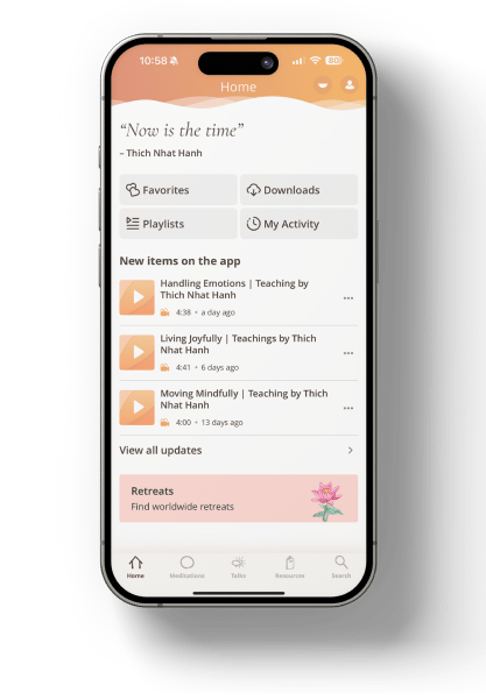Guided Meditation Fundamentals
An Introduction to the Practice and First Exercise

An Introduction to the Practice and First Exercise


Turn Your Inbox into a Dharma Door
Subscribe to our Coyote Tracks newsletter on Substack to receive event announcements, writing, art, music, and meditations from Deer Park monastics.
Support Deer Park
Donations are our main source of support, so every offering is greatly appreciated. Your contribution helps us to keep the monastery open to receive guests throughout the year.
DonateIn the Buddhist tradition, meditation has the power to restore our wholeness, helping us become fresh, stable, and attentive so that we can look deeply into ourselves and our circumstances, seeing clearly our true nature. This insight enables us to transcend suffering and bondage. Once we become more at ease and peaceful, we will no longer cause suffering to others through our actions and speech, and we can begin to transform our surroundings, helping others find ease and peace as well. Meditation has the capacity to heal and transform.
To practice deep looking and deep listening, we must learn how to restore our wholeness, how to become fresh, stable, and attentive. The energy that allows us to do this is mindfulness. Mindfulness enables us to be aware of what is present, what is happening within us and around us. It illuminates the object of our meditation—whether that is a perception, a feeling, a movement, a reaction, or a physiological or physical phenomenon. Mindfulness also has the capacity to look deeply and understand the true nature and roots of what we observe.
In meditation, mindfulness is continuously generated, nurtured, and strengthened. Mindfulness helps us to truly touch life—to be in contact with everything that is happening in the present moment. It allows us to live our life deeply and to practice contemplation, deep looking, and deep listening. The fruit of this practice is insight, awakening, and liberation. Through this process, the knots that bind us—the afflictions of fear, hatred, anger, doubt, and craving—gradually loosen and transform. The barriers that separate us dissolve, and our relationships—with others, with nature—become more harmonious. Ease and joy arise naturally, and the practitioner feels like a lotus bud slowly unfolding.
Indeed, human beings are like flowers, capable of blooming in beauty and freshness. The Buddha is a fully blossomed human flower—radiant, fresh, and beautiful. We all have the potential to become Buddhas. This is why, in meditation centers, when practitioners greet one another, they often place their palms together in the shape of a lotus bud.
"A lotus for you; a Buddha to be"
This is the gatha recited in mindful greeting. (Breathe in as you say, “A lotus bud I offer to you,” and breathe out as you say, “a future Buddha.” Smile as you breathe out, and you will embody the presence of a lotus.)
Even without a teacher or a community, we can still practice on our own. A teacher is someone with experience in the practice and realization. A Sangha is a community of practitioners who follow a similar method of practice. Because everyone in the Sangha practices together, it becomes easier for each individual to practice. The collective energy of mindfulness is very strong and can offer tremendous support if we have the opportunity to practice within a Sangha. We also learn from the experience of others. There are many things we may struggle to do alone, but within a Sangha, they become natural and effortless. Those who have practiced with a Sangha can confirm this truth.
If you have not yet had the opportunity to meet a teacher or a Sangha, this text can serve as a guide for your initial steps. It contains many guided meditation practices, all derived from the teachings of great teachers and communities throughout history. As you practice, you may feel supported in some way by these teachers and Sanghas.
By practicing some of the exercises shown here, you will generate the energy of mindfulness within yourself, becoming fresher, more attentive, and more joyful in daily life. With this foundation, you will have more opportunities to encounter a teacher or a Sangha. Perhaps they are already nearby, but you have not yet had the chance to recognize them. This text may help you find your teacher and your Sangha. Please trust in the practice as you follow the guidance in this text.
In the Buddhist tradition, the Sangha is considered a precious jewel, one of the Three Jewels—Buddha, Dharma, and Sangha. The Three Jewels already exist within you. The Sangha within your heart will lead you to a Sangha in your community. While everything ultimately depends on your own energy of mindfulness, we still wish you “good fortune” on this path, for we are all lotus flowers on the verge of blooming—we are all future Buddhas.

There are many forms of meditation: walking meditation, sitting meditation, tea meditation, working meditation, and more. Here, we are primarily focusing on sitting meditation, particularly guided sitting meditation. Over the past ten years, tens of thousands of people have come to Plum Village to practice meditation. Some have found great success in sitting meditation, while others have flourished more in walking meditation, tea meditation, or working meditation. The guided meditation exercises are designed to support those who may struggle with sitting meditation, though in truth, everyone can benefit from them.
Some practitioners, accustomed to meditating alone, may initially feel uncomfortable with guided meditation sessions. However, many of them have later discovered profound benefits and undergone meaningful transformation through this practice. Practitioners from various places have encouraged us to share these guided meditation exercises widely.
Those who are chosen to guide sitting meditation should be deeply experienced in the practice and have achieved personal transformation through meditation. Guides should be proficient in using the bell of mindfulness, inviting it in a steady, unhurried manner that reflects a state of stability and peace. Their voices should be calm, both gentle and strong, and they should have an intuitive understanding of the needs and conditions of the practitioners.
The themes and duration of each session should be carefully chosen based on this understanding. Ultimately, if the community feels joyful, comfortable, and deeply nourished after each session, then the meditation guide has been successful.
Guided meditations serve various purposes: some bring joy (meditative delight), some help us establish connection, others support healing, contemplation, or letting go. Sometimes a single meditation exercise may serve multiple functions.
Practitioners are often first guided through meditations that nourish the body and mind, known as meditative delight practices. Delight here refers to the joy and peace that arise from meditation, which serves as nourishment for the practitioner. A traditional meal offering chant states:
"When eating, may all beings take the joy of meditation as their food and be filled with the happiness of the Dharma."
The early exercises in this text belong to this category. These practices help us connect with the fresh and wholesome elements within and around us, enabling us to restore balance and begin an inner healing process. They also help us return to the present moment, letting go of distractions and touching the wonders of life.
In addition to nourishment, meditation fosters insight. Deep looking (vipassanā) allows us to observe our thoughts, emotions, and perceptions, illuminating their nature so that we are no longer controlled by them. Insight leads to liberation, healing, and letting go. Some meditations combine several of these elements, and practitioners are encouraged to choose exercises that suit their needs and readiness.
A meditation guide should consider the conditions of the practitioners before selecting a meditation theme, much like a physician prescribing the right medicine for a patient.
Before engaging in a meditation exercise, it is important to understand its principle and purpose. A meditation guide may take a few minutes to introduce the practice beforehand. This text contains basic instructions to support such preparation.
A meditation session may be divided into multiple parts and practiced over several sittings. After each session, the guide should listen to the experiences of the practitioners to refine the approach. Time should be given for each exercise to be practiced with stability and depth.
Breathing in and out carries an image, and the image is used as an anchor for concentration. Deep contemplation is easier when based on an image rather than an abstract idea.
After each segment of the meditation (which may last between ten to twenty breaths, or longer), the guide should not ring the bell abruptly, as this could startle practitioners. Instead, a soft bell sound should be used to signal the transition. The guide’s voice should be expressive, conveying the essence of the meditation in a way that supports practitioners in sustaining their contemplation.
As mentioned, every meditation session should begin with a few minutes of mindful breathing to generate joy and calmness in the mind.
Mindful breathing is a foundational practice in meditation. Few succeed in deep meditation without first mastering this gateway. Conscious breathing opens the path to concentration (samādhi) and wisdom (prajñā).
The Vietnamese Zen master Tăng Hội, the first patriarch of Vietnamese Zen, once said:
"Mindful breathing is the great vehicle that carries all Buddhas."
Mindful breathing leads to the four levels of concentration (dhyānas) and supports the development of insight into impermanence, interbeing, selflessness, and non-duality. Although one may practice meditation without focusing on breath awareness, ānāpānasati (mindfulness of breathing) is the most reliable path. Therefore, all the guided meditations are supported by mindful breathing, known in full as Ānāpānasati, which means “mindfulness of breathing in and breathing out.”
If one does not have a teacher or a Sangha, it is still possible to practice alone using the exercises and instructions in this text. Practicing in a community, however, provides invaluable support. The collective energy of the Sangha can nurture and sustain us, and we can learn from the experiences of fellow practitioners. Even if we do not have many opportunities to consult a teacher, we can always learn from those in the community who exhibit joy and transformation.
These guided meditations can be practiced both within a Sangha and individually. Each form of practice complements and strengthens the other.
If one does not yet have a Sangha, these guided meditations provide a safe and structured practice, avoiding the potential imbalances sometimes associated with esoteric meditation methods. The meditations are grounded in the Buddha’s original teachings, ensuring safety and stability.
Some people do not know what to do when sitting in meditation. They are only taught the posture—how to sit with their seat touching the earth and their head touching the sky. Without further guidance, they may sit for months or years without learning how to regulate the breath or unify body and mind.
"Just sitting" (shikantaza) is a Zen instruction meaning to sit without expecting anything, even enlightenment. Sitting while waiting for something to happen is not true meditation. True sitting means to fully be in the present moment—relaxed, awake, and at ease. This requires practice. Sitting is not just sitting—it is mindfulness and joy in the present moment.
Some practitioners prefer silent meditation and initially resist guided practice, feeling disturbed by the voice and the bell. This is understandable. When sitting silently, the mind and body settle, creating a sense of ease that can be disrupted by external sound.
However, if one remains attached to this stillness without deepening their understanding, transformation does not take place. Some practitioners use meditation as a way to escape from life’s challenges, much like a rabbit hiding in its burrow from hunters. While this may provide temporary relief, it does not lead to true freedom.
Guided meditation helps us touch the wonders of life, cultivate positive seeds, and transform suffering. It is an integral part of the Buddhist tradition. In sutras like the Discourse on the Teachings to Be Given to the Sick, we find examples of Venerable Sāriputta guiding the lay disciple Anāthapiṇḍika through a meditation on impermanence to help him transcend his fear of death.
A guided meditation session often follows a pattern:
In group settings, mindful breathing can be synchronized with music or chanting. Songs such as "Taking Refuge" or "In, Out, Deep, Slow" help the community breathe together in harmony. A leader may guide the group with simple hand gestures to indicate inhalation and exhalation.
With practice, guided meditation becomes a powerful tool for transformation, opening the path to insight, healing, and peace.
Breathing in, my mind becomes calm / Calm
Breathing out, I smile / Smile
Breathing in, I dwell in the present moment / Present moment
Breathing out, this moment is a wonderful moment / Wonderful
Many people begin their meditation practice with this exercise. Some, even after years of practice, continue with it because it consistently brings great benefit.
As we breathe in, we focus on our breath: wherever the in-breath reaches, a sense of calm follows—just as when drinking cool water, we feel refreshed as it flows through our body. In meditation, when the mind is calm, the body also becomes calm, for conscious breathing brings body and mind together as one.
As we breathe out, we smile, allowing all the facial muscles to relax (there are about 300 muscles in our face). The nervous system also relaxes when we smile. A smile is both the result of the calm brought by the breath and the cause that deepens our relaxation, making the experience of peace more tangible.
With the second breath, we return fully to the present moment, cutting through attachments to the past and anxieties about the future, so that we may truly dwell in the here and now. Life is only available in the present moment, and so we must return to this true presence. To be aware that we are alive, that we can touch the wonders of life within and around us—this itself is a miracle. Simply opening our eyes or listening mindfully allows us to receive the beauty of life.
Thus, the present moment can be the most beautiful and wonderful moment—if we practice the first breath repeatedly before moving on to the second.
This exercise can be practiced anywhere: in the meditation hall, on a train, in the kitchen, by the river, in the park, whether walking, standing, lying down, sitting, or even while engaged in daily work.
From time to time we offer multi-week courses related to mindfulness, the teachings and life of Thich Nhat Hanh, and a variety of similar subjects. Please see our schedule of upcoming courses.

Take the Deer Park Monastery and Plum Village community with you wherever you go. The Plum Village app is designed to cultivate mindfulness, compassion, and joy through guided meditations, deep relaxations, practice poems, bells of mindfulness, and other practices — all through a mobile device.
